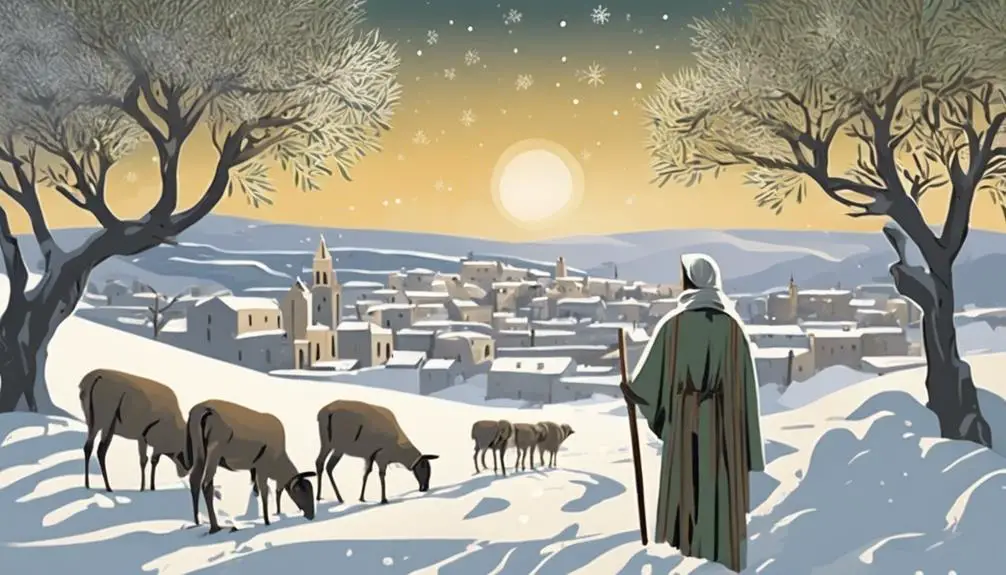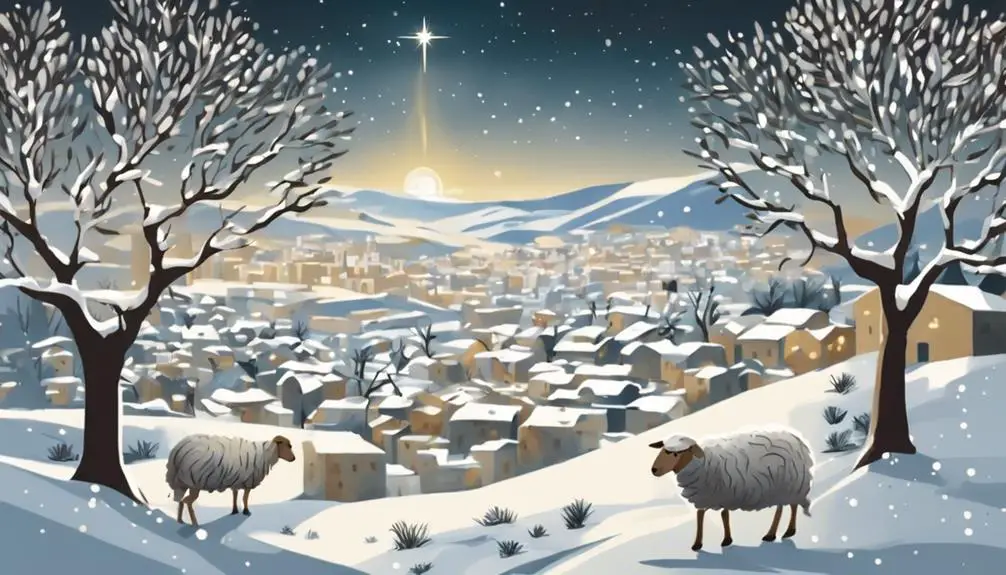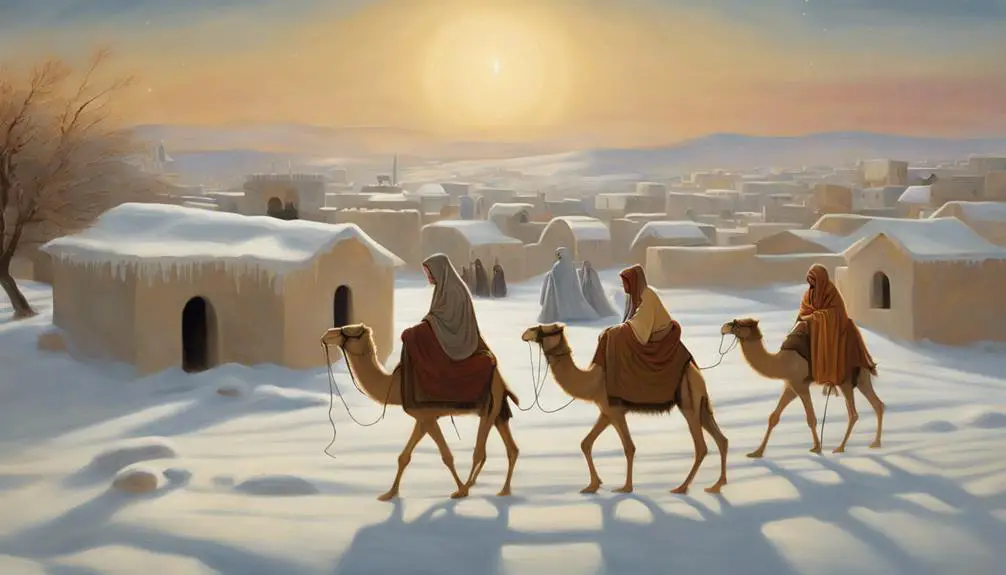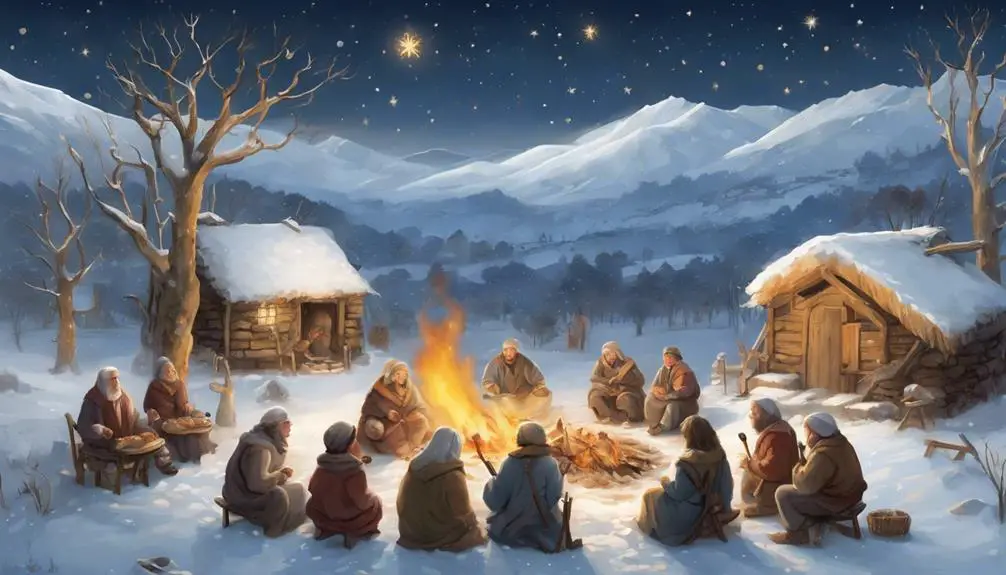Learn about winter's profound symbolism in the Bible, uncovering its mysteries and the spiritual lessons hidden within its chilly embrace.

Winter in the Bible
Have you ever considered how winter weaves its way through the tapestry of the Bible? As you explore the scriptures, you'll discover that winter isn't just a backdrop for historical events; it holds deep symbolic significance, from moments of divine intervention in the coldest of times to the spiritual reflection it invites.
Winter's role in prophecy and the stories of cold weather miracles provide a richer understanding of the season's impact on faith and spiritual growth. Let's embark on a journey through the biblical winters, uncovering their hidden meanings and the reasons they hold a place of importance in scripture.
Key Takeaways
- Winter symbolizes spiritual rebirth, renewal, and opportunities for introspective growth in Biblical narratives.
- It serves as a metaphor for divine intervention, showcasing God's power through miracles and transitions.
- The season emphasizes the importance of endurance, hope, and faith during spiritual and physical hardships.
- Biblical winter stories encourage reflection on personal development, justice, mercy, and stewardship.
Biblical Symbolism of Winter

In the Bible, winter isn't merely a season; it symbolizes a period of spiritual dormancy and anticipation, reflecting themes of death, renewal, and the promise of rebirth. This metaphorical usage encourages you to delve deeper into the spiritual lessons woven throughout the Scripture, beyond the literal cold and barren landscapes. The cycle of seasons—particularly the transition from winter to spring—serves as a powerful canvas, illustrating God's master plan for spiritual awakening and growth.
Harvest imagery, deeply embedded in biblical narratives, often juxtaposes the barrenness of winter with the abundance of the harvest season. This contrast isn't merely agricultural; it's imbued with spiritual significance. You're invited to consider the seasons of your own life, recognizing periods of spiritual barrenness as precursors to times of fruitful abundance. This cyclical pattern mirrors the agricultural cycle but on a spiritual plane, emphasizing God's timing and the importance of patience and faith during the 'winter' seasons of the soul.
Renewal themes are also prevalent, with winter's end symbolizing a shedding of the old and the budding of the new. Just as the earth rejuvenates and life springs forth after the cold months, you're reminded of the promise of spiritual renewal and the hope of resurrection. This theme encourages a reflection on personal growth and the transformative power of faith, even—or especially—through the challenging 'winters' of life.
Through these motifs, the biblical symbolism of winter transcends the physical season, offering profound insights into spiritual dormancy, anticipation, and the promise of renewal. It's a reminder that after every winter, no matter how harsh, comes the promise of spring and new life.
Winter's Role in Prophecy

Winter's role in biblical prophecy often serves as a backdrop, subtly shaping narratives and foretelling significant spiritual transitions. You'll find that the cold, barren landscape of winter isn't just a physical setting but a thematic device that enriches the prophetic messages woven throughout the Bible. This season, with its inherent hardships, becomes a metaphor for periods of spiritual warfare and testing, setting the stage for the unfolding of God's plans.
When examining winter warfare in biblical texts, it's crucial to recognize how this concept goes beyond mere physical battles. It encapsulates the struggle between divine will and human resistance, the clash of spiritual forces in the heavenly realms. The harsh conditions of winter amplify the challenges faced by those awaiting redemption, making their eventual victory all the more poignant. This strategic use of winter underscores the importance of prophetic timing, illustrating how God's interventions are meticulously planned, aligning with seasons of greatest need.
The timing of prophecies isn't arbitrary; it's profoundly significant. Winter, with its symbolism of death and dormancy, often precedes major acts of salvation and renewal. This season's inclusion in prophecy highlights moments of transition, where the old is passing away, and the new is about to spring forth. It's a reminder that in the midst of the coldest, most barren seasons, God is actively working, preparing the ground for what's to come.
In essence, winter's role in prophecy is multifaceted. It's not just a backdrop but a key player in the narrative of redemption, symbolizing both the challenges to be overcome and the promise of renewal that lies ahead.
Cold Weather Miracles

Throughout the Bible, cold weather miracles serve as profound demonstrations of God's power, challenging the limitations of human understanding and redefining the boundaries of divine intervention. These narratives, far from being mere accounts of meteorological phenomena, symbolize the transcendence of spiritual over physical realms. They invite you to explore the depths of faith and the omnipotence of the Creator, who commands even the elements of nature.
Consider the phenomenon of frozen manna. This sustenance, provided to the Israelites, wasn't just miraculous food; its condition in the cold mornings was a testament to God's meticulous care and provision. The frozen state of manna, defying the natural decay typical in desert conditions, represents a divine preservation and an assurance of survival. It's a clear indication that God's miracles aren't confined by the expected norms of nature but are tailored to the needs of His people, demonstrating His intimate involvement in their lives.
Similarly, the concept of ice parting—though not explicitly detailed in the Bible—can be interpreted through instances where God intervenes to create pathways of salvation for His followers. Just as the Red Sea parted, one can infer the capability of God to divide ice for the deliverance of His people, should such a miraculous act align with His divine will. This potential act of ice parting would be a vivid illustration of God's sovereignty over the natural order, reinforcing the belief in His power to provide ways out of seemingly insurmountable barriers.
These cold weather miracles, then, aren't just tales of survival against the odds but are profound theological statements about God's mastery over creation, His care for humanity, and the limitless scope of His power.
Seasons of Spiritual Reflection

Reflecting on the cold weather miracles that highlight God's dominion over nature leads us to consider how the changing seasons serve as periods for deep spiritual introspection. Winter, with its stark landscapes and shorter days, naturally invites a growth pause—a time when the bustling activities of life slow down, allowing for a more inward focus. This seasonal shift isn't merely a physical phenomenon but also a metaphor for spiritual cycles.
In this contemplative space, reflection methods become vital tools. Scriptural meditation, prayerful introspection, and journaling are practices that can guide you through this period of spiritual hibernation. Each method serves to deepen your connection with God, helping to unearth insights that are often obscured during life's busier seasons.
Analyzing biblical narratives, we see that many figures experienced significant spiritual breakthroughs during times of isolation or change, akin to a winter season in their lives. These stories underscore the importance of embracing these growth pauses, viewing them as divinely appointed times for reflection and renewal.
Moreover, this season of spiritual reflection isn't solely about personal introspection. It's also a period for assessing one's impact on their community and the broader creation. How does one's life align with God's intentions for justice, mercy, and stewardship of the Earth? Winter's introspective nature prompts these critical considerations, offering a unique opportunity to realign our actions with our spiritual convictions.
Thus, winter's cold embrace serves not as a barrier to growth but as a catalyst for profound spiritual development and reevaluation. Through intentional reflection methods, this season can become a foundational period for reinvigorating one's faith journey.
Hardships and Hope in Winter

Amid the starkness of winter, you may encounter profound hardships, yet this season also unveils unique opportunities for hope and renewal. The biblical narrative often uses winter as a backdrop for lessons in endurance and the promise of rejuvenation. This duality isn't merely about the changing of seasons but reflects deeper spiritual truths. Winter, with its frozen metaphors, serves as a canvas for depicting life's trials and the resilience required to overcome them.
- Frozen metaphors: The Bible frequently employs images of cold, barren landscapes to symbolize periods of spiritual desolation or challenge. These frozen metaphors aren't ends in themselves but are indicative of the potential for spiritual awakening and growth.
- Endurance lessons: Stories of winter in the Bible are replete with teachings on endurance. They illustrate how perseverance through the coldest seasons of life can lead to the warmth of God's grace and redemption.
- Promise of renewal: Just as winter inevitably gives way to spring, biblical narratives promise that suffering and hardship can lead to renewal and new life for those who maintain their faith.
- Spiritual preparation: The hardships of winter can serve as a time for deep spiritual preparation, encouraging you to fortify your faith and ready yourself for the growth that follows adversity.
- Hope in the cold: Even in the bleakest winter tales, the Bible whispers the possibility of hope. It suggests that within every trial, there lies an opportunity for transformation and the emergence of a stronger faith.
Analyzing these elements reveals how winter, with its inherent challenges, is also rich with opportunities for spiritual enlightenment and renewal.
Celebrating Winter Festivities

While winter's hardships illuminate lessons on endurance and spiritual growth, this season also encompasses moments of joy and celebration through its festive occasions. You'll find that winter customs are deeply embedded in the fabric of cultural and religious observances, offering a rich tapestry of communal bonding and spiritual reflection. These customs often involve the donning of festive garments, symbolizing purity, renewal, and the welcoming of brighter days ahead.
Analyzing these winter customs from a biblical perspective, one notices a profound connection between the physical and spiritual realms. The use of festive garments, for instance, isn't merely a cultural tradition but carries deeper spiritual significance. These garments often serve as metaphors for spiritual purity and preparation, mirroring the biblical call for readiness and transformation. In this light, celebrating winter festivities transcends mere seasonal joy; it embodies an act of spiritual renewal and dedication.
Moreover, the communal aspect of these celebrations can't be overlooked. They foster a sense of unity and shared purpose, reflecting the biblical principles of fellowship and communal support. This communal celebration, enhanced by the special attire, acts as a visible testament to the collective faith and hope of a community, reinforcing bonds and encouraging spiritual growth.
Frequently Asked Questions
How Did Biblical Figures Adapt Their Clothing and Shelter to Cope With Winter Conditions?
To cope with winter, you'd likely adapt your clothing and shelter for warmth, much like historical figures did. Thick, layered garments and insulated shelters were essential.
Travel difficulties due to harsh weather necessitated such adaptations, as well as the development of seasonal rituals to mark time and prepare for colder months.
These strategies weren't just about survival; they reflected a deep understanding of and respect for the rhythms of nature and the challenges posed by the winter season.
What Were the Primary Sources of Heat and Warmth During Biblical Winters, and How Were They Obtained or Produced?
To stay warm during winters, you'd primarily rely on firewood gathering and the use of animal skins.
Gathering firewood wasn't just about picking up fallen branches; it involved a deep knowledge of which woods burned longest and hottest.
Animal skins, on the other hand, required skill in hunting and processing to create insulative clothing and blankets.
Both methods demanded a keen understanding of available resources and the ingenuity to utilize them efficiently.
How Did Winter Impact the Dietary Habits and Food Availability in Biblical Times?
During winter, your dietary habits would've shifted due to changes in food availability. You'd lean on preserved foods and grains stored from previous harvests.
Agricultural adjustments were crucial, as certain crops wouldn't survive the cold. Winter festivals often featured foods that were rare or preserved, making these events not just cultural, but also vital for communal sustenance.
This seasonal shift encouraged ingenuity in preservation techniques and dietary diversity.
Are There Any Specific Prayers or Psalms That Were Traditionally Recited During the Winter Months in Biblical Times?
You're wondering if there were specific prayers or psalms for the winter months.
While the Bible doesn't explicitly mention prayers exclusive to winter, it's rich with seasonal metaphors that could have framed prayers during these times.
For example, winter festivals might've inspired reflections on themes of renewal and hope, found in verses that metaphorically reference winter's hardships.
These insights suggest a nuanced, interpretive approach to understanding seasonal spirituality in biblical times.
How Did the Concept of Winter Influence the Design and Construction of Buildings and Structures in the Bible?
In considering how winter influenced ancient construction, you'd find that buildings and structures were designed with the seasonal challenges in mind. The timing of winter festivals and the agricultural cycles played a crucial role.
Builders integrated features to withstand cold and store harvests, ensuring communities thrived even in the harshest months. This approach wasn't just practical; it was a deeply ingrained response to the rhythms of nature, reflecting an intuitive understanding of their environment.
Conclusion
In the biblical narrative, winter isn't just a cold, barren season. It juxtaposes the starkness of physical hardship with the warmth of spiritual renewal, offering a profound paradox.
As you've journeyed through scripture, you've seen how winter, with its trials, also brings moments of miraculous grace and deep reflection. It underscores a pivotal biblical theme: out of hardship blooms hope.
This duality enriches the biblical understanding of winter, making it a season not just of survival, but of profound transformation and celebration.



Sign up